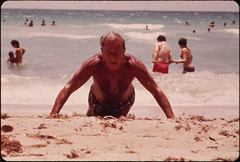
Dr. A. Houwink et al of the Department of Rehabilitation, Nijmegen Centre for Evidence Based Practice, Radboud University Nijmegen Medical Centre, Nijmegen, The Netherlands. writing for Arch Physical Medical Rehabilitation. September 2011 discuss the following study:
The objective was to investigate the interrater reliability and construct validity of the Stroke Upper Limb Capacity Scale (SULCS).
The setting for this study was the inpatient department of a rehabilitation center.
The participants were patients after stroke (N=21; mean age ± SD, 61.7 ± 7.9y; 57% men), undergoing inpatient rehabilitation.
The SULCS was administered by occupational therapists (OTs) within 6 weeks after stroke (t1), 3 months after t1 by the same OT (t2), and within 1 week after t2 by another OT (t3). Interrater reliability, the repeatability between different raters, was assessed by calculating the intraclass correlation coefficient (ICC) based on the scores at t2 and t3. Construct validity, indicating agreement with hypotheses concerning the construct that is being measured, was assessed with Spearman rank correlation coefficient (ρ). The SULCS scores were cross-sectionally correlated with those of the Action Research Arm Test (ARAT) and the Rivermead Motor Assessment (RMA) at t1, and longitudinally with the respective change scores between t1 and t2.
The results found were that the SULCS (range, 0-10) had a high ICC (.94; 95% confidence interval, .86-.97) and strong cross-sectional correlation with both the ARAT and the RMA (ρ=.91 and ρ=.85, respectively), while the respective change scores showed a strong correlation with the ARAT (ρ=.71) and a moderate correlation with the RMA (ρ=.48).
The conclusions drawn were that the SULCS has good interrater reliability and construct validity.
Upper limb capacity in stroke patients can be improved through the use of the ArmTutor.
The ArmTutor™ system has been developed to allow for functional rehabilitation of the upper extremity. The newly developed system is being used to improve the mobility of patients who have Parkinson’s disease, CP, MS, upper and lower limb surgeries, brain/spinal cord injuries and others. The system consists of an ergonomic wearable arm brace and dedicated rehabilitation software. The ArmTutor™, which includes the HandTutor, LegTutor and 3DTutor, system allows for a range of biomechanical evaluation including speed, passive and active range of motion and motion analysis of the upper extremity. Quantitative biomechanical data allow for objective evaluation and rehabilitation treatment follow up. The ArmTutor™ rehabilitation concept is based on performing controlled exercise rehabilitation practice at a patient customized level with real time accurate feedback on the patient’s performance. The exercises are designed in the form of challenging games that are suitable for a wide variety of neurological and orthopedic injury and disease.The games challenge the patient to perform the exercise task to their best ability and to continue exercise practice.
The ArmTutor™ allows for isolated and a combination of elbow and three directional shoulder treatment. The system provides detailed exercise performance instructions and precise feedback on the patients exercise performance. Controlled exercise of multijoints within the normal movement pattern prevents the development of undesired and compensatory joint movement and ensures better performance of functional tasks.
The ArmTutor™ system is used by many leading rehabilitation centers worldwide and has full FDA and CE certification. See www.HandTutor.com for more information.
No comments:
Post a Comment